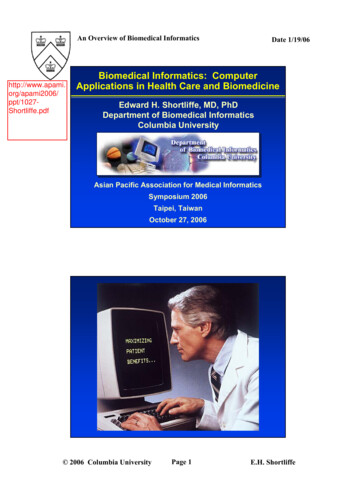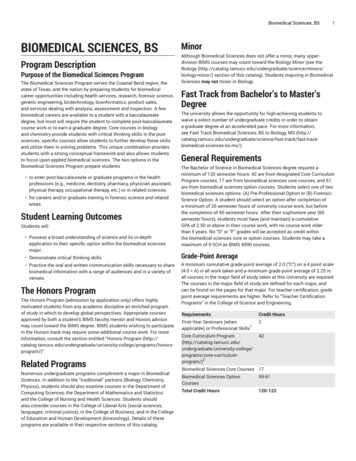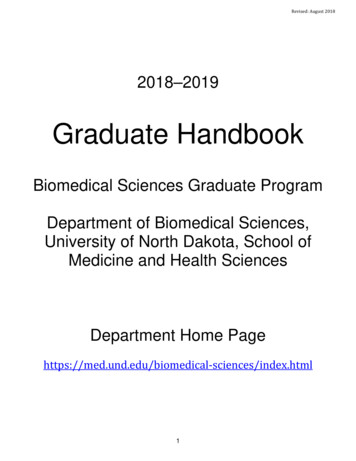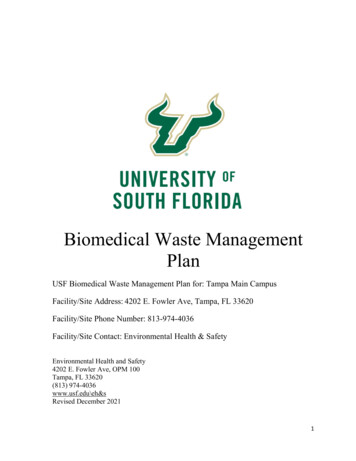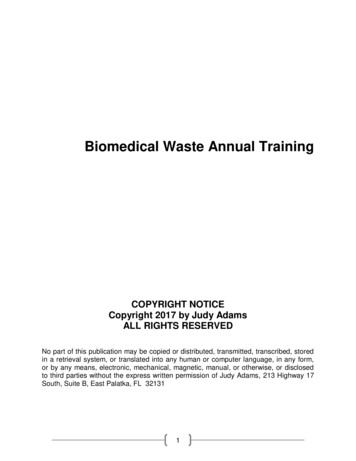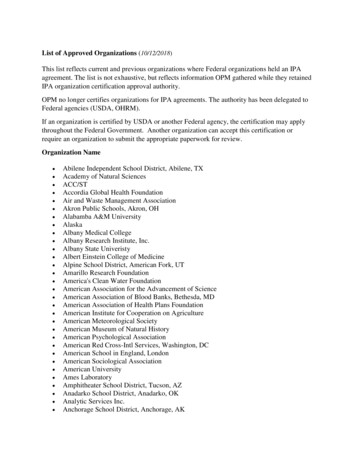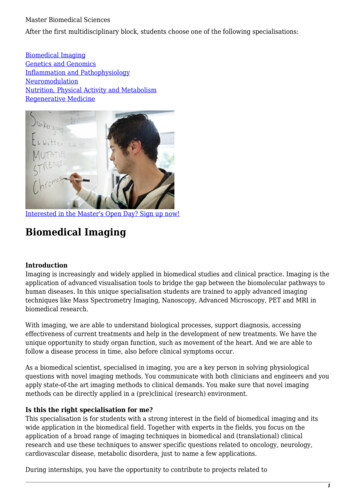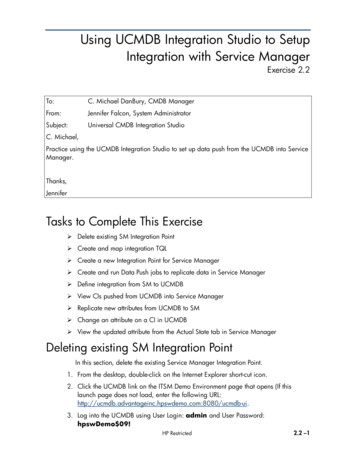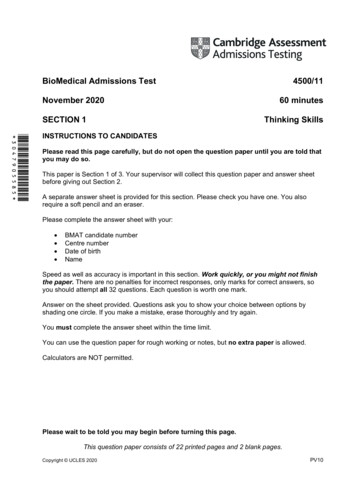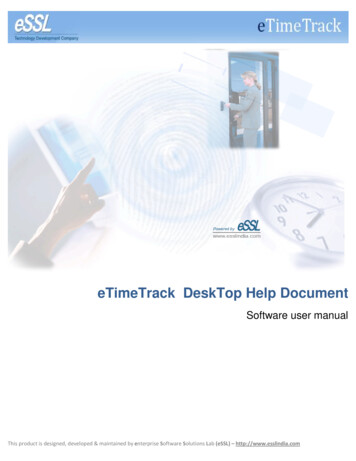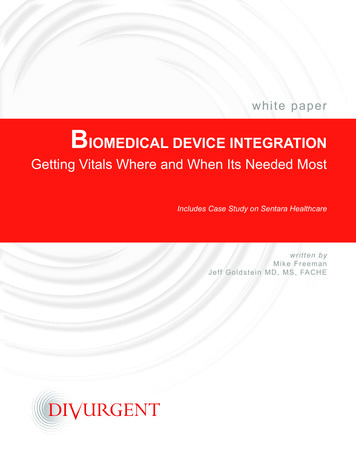
Transcription
wh ite p a p e rBIOMEDICAL DEVICE INTEGRATIONGetting Vitals Where and When Its Needed MostIncludes Case Study on Sentara Healthcarew r i tte n b yM i ke F r e e m a nJ e ff G o ld s t e in M D, M S, FAC H E
IntroductionIn the world of medical technology, increasing connectivity across care settings to get vital real-time patient healthinformation into electronic medical records (EMRs) is of growing importance with the accelerated adoption of EMRsoccurring across the country. As The Centers for Medicare and Medicaid Services (CMS) sees their Meaningful Use ofElectronic Health Records (EHRs) program helping increase the procurement and implementation of EHRs across eligiblehospitals and eligible providers (48% and 19% respectively that have received incentive payments through May 2012),i theopportunity for biomedical device integration (BMDI) is becoming ever more important. In this white paper, we providesome insights to key issues in BMDI implementation, a case study on Sentara Healthcare and how they have managed theirBMDI program, and benefits from BMDI implementations.Age of Accountable Care and the Need for ConnectivityThe nation’s health system is advancing into the age of accountable care supported by the health information technology(HIT) renaissance period occurring in the industry. Federal health reforms incentivizing EMR adoption, increased focus onconsumerism, development of more patient-centric systems, and the growing need for real-time patient health informationare all contributing to the need for improved connectivity to support care provider teams across the United States (US)healthcare system. The opportunity to leverage data from integration of medical devices is improving care delivery andclinical care administration processes with an ultimate focus of improving health outcomes.Physicians and their care provider teams are gaining greater access to use of real-time data and BMDI initiatives areenabling this capability. Linking together the components in the technology architecture means integrating medical devicesfrom across a hospital/health network’s inpatient, ambulatory, and in some cases home care setting with the EMR. Withthe growth in Personal Health Records (PHRs), the importance of collating this clinical data becomes even more importantas well. More importantly, BMDI enhances the richness of comprehensive data sets available within a patient’s healthrecord with data collected from care settings spanning emergency departments, operating rooms, intensive care units, andothers where vital information is collected for use in the immediate care setting and made available for health informationexchange as part of the patient’s longitudinal care record.Accountable care organizations (ACOs), clinically integrated networks (CINs), health information exchanges (HIEs) , primarycare and specialty care practices alike are all facing this need for increased connectivity and richer data on the patientsthey provide care for in their inpatient care settings. When data feeds directly into the EMR, physicians and caregiverteams have a central repository for the information they need. Overcoming challenges to enable connectivity and improvethe value of the knowledge and evidence available for clinician and physician decision-making is critical. A few challengesinclude:dImproving healthcare with client focused solutions. 2012 DIVURGENT - All Rights Reserved 1
TopicChallengeData TranscriptionIntegrating medical devices into a healthcare organization’s health information technology (HIT)architecture to decrease manual transcription of data.iiInteroperability and Ensuring interoperability among components within both the network and data architecture Communications(e.g. use of common communication standards).iiiDevice DriversHaving device drivers that are “specific to each vendor, type and version of medical device.”iv andthat maintain the same operational parameters across various software releasesStaff EngagementInvolving clinicians in the selection and set up and configuration between biomedical devicesand EMRs.Alarm Management Device interfacing to filter critical and non-critical alarm data through appropriate servers tomitigate “alarm overload.”vTestingMedical device integration testing to ensure trust in the system and validation of the data.Positive Patient Iden- Implementation of positive patient identification (PPID) for vitals collection, validation, and subtificationmission to EMRs can cause interruption with clinical workflow.viOvercoming these challenges to maximize the capabilities of BMDI requires transformation of the processes and structuresof care that are increasingly connected through HIT. As noted by Flareau and colleagues, “For CINs and ACOs, healthinformation technologies serve important functions of giving teams real-time access to patient records; monitoring andmeasuring quality and outcomes ”vii BMDI enhances this ability for real-time access to comprehensive and meaningfuldata. Delivering on the potential of ACOs and CINs will require significantly more robust quality reporting to evaluateoutcomes and this will only be possible with richer, more timely and more accurate data and patient health information.The vital statistics available through BMDI provide the physicians and clinicians evaluating outcomes with deeper insightsat the population level from which quality initiatives can be fine tuned for the benefit of the patients being served by ACOsand CINs.So what does this more robust data set give us that we obtain from BMDI? One answer comes from the growing interestin Big Data.BMDI and Big DataGetting the data from biomedical devices into an organization’s EMR is a key part of the landscape of data sets supportsthe drive toward Big Data sets. Big Data has been defined as, “ Big data (also spelled Big Data) is a general term used todescribe the voluminous amount of unstructured and semi-structured data a company creates -- data that would take toomuch time and cost too much money to load into a relational database for analysis.”viii What are some of the benefits tobe derived from medical device integration in regards to Big Data? There are three to consider that include data accuracy,timeliness of data delivery to the caregiver and decision maker, and frequency and availability of the data.First consider data accuracy. A challenge that occurs prior to implementing BMDI with EMRs is the requirement for manualdata transcription from one system to another that can lead to both time delays and inaccuracies. When medical devicesare integrated with EMRs to have automated data streaming, the opportunity for improving the quality of the patient’sinformation and the timing for which it is available for use by care givers increases exponentially.ixwww.DIVURGENT.com 1.877.254.9794 info@DIVURGENT.com 2012 DIVURGENT - All Rights Reserved 2
Second, is data delivery to the decision makers. With BMDI in place, clinical decisions by physicians and caregivers at thepatient level can be improved from having a more complete picture of the health statistics/data and vitals on the patient.At the executive level, larger data sets are needed (i.e., Big Data) to conduct deeper retrospective and more importantly,predictive analysis for population health evaluations to gauge improvement of outcomes by ACOs and CINs.x BMDI makesthese data sets more robust at the micro and macro levels thereby improving clinical and relevant administrative decisionmaking.Third, is frequency and availability of the data. Once medical devices are integrated into the healthcare organization’s HITarchitecture, access to the information generated by the devices can be made available in real time. As systems acrossan architecture change and upgrades occur over time, testing and validation to ensure that interfaces are not impactedbecome essential (one of the key challenges with BMDI implementations) to ensure that access to information remainsavailable.One organization that has made tremendous strides in the implementation of BMDI is Sentara Healthcare. The followingcase study on Sentara provides insights to successful efforts at overcoming the challenges with BMDI and providing aneffective solution to help physicians and clinicians with accurate and timely flow of patient health data into the EMR frommedical devices across the care delivery setting spectrum.CASE STUDYBMDI at Sentara HealthcareSentara Healthcare (Sentara), with 10 acute care hospitals and over 100 sites of care across Virginia and northeast NorthCarolina, is a leading integrated care delivery service provider. In 2008, Sentara having embarked upon the implementationof Epic’s EMR solution for their hospitals and ambulatory practices started developing the roadmap for integrating theirbiomedical devices into their hospital operations. From Sentara’s perspective, biomedical device integration (BMDI) is theapproach to automate the delivery of biomedical device data into the Epic EMR. Sentara’s biomedical device integrationteam is comprised of one technical manager and three systems administrators. As of the summer 2012, the team at Sentarahas integrated more than 2,000 biomedical devices into the EHRs at eight of Sentara’s 10 hospitals. Additionally the BMDIteam supports their Philips VISICU application for remote monitoring of ICUs, General Electric’s (GE) QS application usedin labor and delivery departments for fetal monitoring, and mobile EMR applications.The initial project scope that launched September 2006 included: Eight Hospitals. (ED, ICU, PACU, ENDO, L&D) Integration of Nursing data pointsImproving healthcare with client focused solutions. 2012 DIVURGENT - All Rights Reserved 3
The follow up project scope that launched August 2011 included: Eight Hospitals. (ORs, ENDO, ASC, Cath Lab, ERCP, etc); Integration of Anesthesia data points; Outfit Anesthesia machine with needed hardware; Six completed as of August 14th, 2012; Project completion, November of 2012.Figure 1 offers a high level overview of the BMDI implementation at SentaraFigure 1. Sentara BMDI OverviewThis figure shows the configuration of data flowing from devices into a middleware (interface engine) and eventually intothe Epic EMR. Best practices leveraged from Sentara’s past health information technology implementations included: Have a physician led governance group that makes key decision on system level variables and standards. Focus on integrating one facility at a time due to variation in possible workflows and need to ensureoptimal customer service at each facility. Review hardware in departments at least 3-months (preferably 6-months) in advance to ensure eachdepartment is ready for BMDI.www.DIVURGENT.com 1.877.254.9794 info@DIVURGENT.com 2012 DIVURGENT - All Rights Reserved 4
Figure 2 provides a high level illustration of the key architecture components in the BMDI project at Sentara.Figure 2. Sentara BMDI ProjectsHaving a variety of devices from different vendors, as is the case at Sentara, requires standardizing the device integrationand is a critical element for any BMDI initiative. At Sentara, two integration methods were used to achieve standardization;Philips via their HL7 feed from 34 Philips database servers and secondly, Capsule via their terminal servers (e.g., digiboards). For Capsule deployment, close to 500 four and eight port terminal servers and 12 virtual servers (eight for nursingworkflow, three for anesthesiology workflow, and one for NICU alarm integration) were used. The terminal servers arenot running on a PC operating system and do not require security patches to be installed. They are solely dedicated to theintegration process, and have produced high reliability for several years.Sentara BMDI Implementation ApproachThe approach to a BMDI implementation should be tailored to fit the care delivery environment. At Sentara, the firststeps include meeting with the customers to identify departments and devices involved and then setting the scope andfrequency that vitals are needed. Next, the BMDI solution is designed that is then followed by the most crucial step oftesting (one of the key challenges noted earlier) to confirm that cables are pinned out correctly and that hardware devicesare functioning correctly prior to go-live. For new devices, always confirm the format and location of the data in the EMRbefore integration.BMDI Clinical Workflows: AnesthesiaA prime example comes from anesthesia data collection and transmission. Some of the key workflow considerations forintegrating these devices include:Improving healthcare with client focused solutions. 2012 DIVURGENT - All Rights Reserved 5
The patient’s EMR record is linked to a computer that is attached to the Anesthesia machine. A Capsule terminal server is attached to the anesthesia machine, which transmits the device data from theanesthesia machine and physiological monitor. Device data enters Epic every minute as validated. The anesthesiologist can un-validate data artifacts. The system generates approximately 60,000 messages/day in Epic.Figure 3 tracks how the patient-specified data flows through they systemFigure 3. Anesthesia Patient Dataflowwww.DIVURGENT.com 1.877.254.9794 info@DIVURGENT.com 2012 DIVURGENT - All Rights Reserved 6
As this project is nearing completion later this year, a number of lessons learned have been gathered that include: Investigate medical device inventory and software revisions/configuration. Identify legacy devices that need to be replaced. Obtain a list of variables from EMR application team and communicate which variables will come inautomatically and which ones will not. Don’t assume all locations are setup the same, even if they have similar hardware. Work with EMR application teams to identify level of involvement and expectations. Understand how labels on monitors can affect what is being sent to Capsule, IE and Epic. Have network drops run 2 months in advance and preferably to the same IT closet. Setup equipment at least one month prior to go-live. For multiple systems, allow enough time between go live at each facility. Standardize as much as possible and choose vendors that provide a neutral solution and allow flexibility fordevices.In June 2012, Sentara’s approach and lessons learned in BMDI was presented via a webinar through Healthcare Informaticsxi.Sentara’s strategic BMDI team model represents a novel approach advanced from typical industry approaches to medicaldevice EMR integration projects and is illustrated in Figure 4 with the biomedical device integration team at the heart ofthe initiative.Figure 4. BMDI Team Implementation Model at SentaraImproving healthcare with client focused solutions. 2012 DIVURGENT - All Rights Reserved 7
Traditional BMDI implementations have engaged a three-team structure with Information Technology teams, Nursing/Clinical teams and a biomedical team. At Sentara a modified approach has been taken focusing on the four quadrantsdisplayed in Figure 4. Key to this approach is recognizing the matrix requirement for resourcing and partnering. The BMDIteam helps the members of each of the other four teams by “bridging the gap” to meet specific needs of mitigatingworkflow challenges, alert issues, and improving communications across the teams to manage upgrades and updates,maintain focus, and ensure that standards (i.e., HL7 and other protocols) are rigorously adhered to for compliance.Value from BMDI ImplementationsThere is great value to be obtained from BMDI implementations. As the challenges are addressed and barriers are overcomethe opportunities to capitalize on more timely, accurate, and getting the right data in the right place in a real-time or nearreal-time manner increase dramatically. Value derived from these projects can be thought of both financially and interms of clinical efficiency. Total cost of ownership is common for evaluating the financial ROI associated with EMRs (andassociated challenges with evaluating it) and is also important for management to consider with a BMDI implementationxiiWhen embarking on a project such as this, organizations should therefore consider: the original implementation cost ongoing support, staffing and training required system upgrades for the devices themselves device life expectancy from MTBF (mean time between failure) data drivers, servers, and other associated network/cloud applications to keep pace with upgrades to theorganization’s EMR.In one case from a BMDI implementation at the University of Alabama Birmingham (UAB) the benefits to the nursingoperations provided a strong example of improvement in clinical efficiency. These gains were summarized as, “As a resultof the BMDI implementation, nursing has achieved a significant reduction in average time for documenting vital signs,dropping from four minutes to 20 seconds, a 92% efficiency gain. The total time that was reallocated to direct patient careper nurse per shift varied from 227 minutes to 79 minutes depending on the specific unit’s care protocols.”xiiiAdditional benefits to be achieved by organizations such as UAB, Sentara and others may include providing clinicians moretime for patient care activities, increased reliability of vital sign data, and improved use of best practice alerts related tochanges in vital sign data. As the adoption of EMRs continues to accelerate across the US healthcare system, increasedattention to BMDI implementations will continue to be a growing priority for healthcare provider organizations.www.DIVURGENT.com 1.877.254.9794 info@DIVURGENT.com 2012 DIVURGENT - All Rights Reserved 8
ABOUT THE AUTHORSMike Freeman has over 13 years of experience in inforamtion technology, with 11 of those years working in HealthcareIT, and has been operating as Manager of the biomedical device integration team at Sentara Healthcare for over 2 years.Jeffrey Goldstein MD, MS, FACHE is a senior consultant of Clinical Transformation at Divurgent. Dr. Goldstein is a recognizedleader in healthcare spanning over two decades guiding a variety of hospitals worldwide to reach their clinical, operationaland financial goals.His career includes serving as Medical Director, hospital CIO and COO, and primary consultant to hospitals, health caresystems and government regulatory agencies. Dr. Goldstein has served on numerous regional and national committeesfor addressing issues to improve America’s health by bringing together providers, payers and consumers that resulted inpractical and viable solutions for improving clinical outcomes, patient safety and organizational efficiencies.Dr. Goldstein received his medical degree from CETEC University School of Medicine and completed his Residency trainingin Family Practice at SUNY Stony Brook – Glen Cove Hospital. He also holds advanced degrees in Electrical and BiomedicalEngineering from SUNY Buffalo and the University of Connecticut. He is a Fellow of the American College of HealthcareExecutives where he was the national chairperson for the college’s Physician Special Interest Group as well as serving onthe NJ Regent’s Advisory Council and also a member of the American College of Physician Executives.COMPANY OVERVIEWDivurgent is not the typical healthcare consulting firm. As a nationally recognized company, we strive to be different, tothink outside of the box for innovative healthcare solutions.Our goal is simple. To transform healthcare to our clients and the communities they serve.Focused on the business of hospitals, health systems and affiliated providers, Divurgent believes successful outcomes arederived from powerful partnerships.Recognizing the unique culture that every organization offers, we leverage the depth of our experienced consulting team tocreate customized solutions that best meet our client’s goals. Utilizing best practices and methodologies we help improveour client’s operational effectiveness, financial performance and quality of patient care.Improving healthcare with client focused solutions. 2012 DIVURGENT - All Rights Reserved 9
Referencesi.Anthony R. Data on Stage Meaningful Use Attestation and Barriers. CMS update briefing to the ONC-HIT Policy Committee at July10, 2012 meeting. Accessed online August 1, 2012, at nters/hit-policy-committeeii.Hernando EM, Pascual M, Salvador CH, Garcia-Saez G, Rodriguez-Herrero A, Martinez-Sarriegui I, Gomez EJ. Definition ofInformation technology Architectures for Continuous Data Management and Medical Device Integration in Diabetes. J DiabetesSci Technol. 2008;2(5):899-905.iii. Hernando EM, et al. 2008.iv. Getting Devices to Talk to EHRs. HealthData Management. November 1, 2009. Accessed online August 8, 2012, at http://www.healthdatamanagement.com/issues/2009 72/-39279-1.html.v.VanKampen DW. Alarm Integration and Beyond. 24x7 Mag. November 2010. Accessed online July 20, 2012, at http://www.24x7mag.com/issues/articles/2010-11 10.asp.vi. Grate M. Exploring a Sustainable Technology: BMDI. HIMSS News. May 2012. Accessed online July 27, 2012, at tentId 80112&type HIMSSNewsItem.vii. Flareau B, Yale K, Bohn JM, Konshak C. Technology Advancements. In: Clinical Integration: A Roadmap to Accountable Care. 2ndEd. Virginia Beach, VA: Convurgent Publishing; 2011:163-164.viii. Big Data definition. SearchCloudComputing. Accessed online August 17, 2012, at ion/big-data-Big-Data.ix. Witonsky P. Leveraging EHR Investments Through Medical Device Connectivity. HFMA. August 1, 2012. Accessed online August15, 2012, at id 33698.x.McNickle M. 4 tips for leveraging big data. Healthcare IT News. April 17, 2012. Accessed online August 10, 2012, at http://www.healthcareitnews.com/print/45436.xi. Capsule and Sentara Healthcare Launch BMDI Project to Improve Patient Care and Recover Nursing Hours. Enhanced OnlineNews. May 30, 2012. Accessed online August 28, 2012 at ra-Healthcare.xii. Witonsky P. 2012.xiii. Hicks J. No. 5: UAB Health System. Highlighting devices: Ala. health system develops biomedical devices integration forEMRs. Modern Healthcare. June 29, 2009. Accessed online July 6, 2012, at ww.DIVURGENT.com 1.877.254.9794 info@DIVURGENT.com 2012 DIVURGENT - All Rights Reserved 10
OUR COMMITMENTDIVURGENT is dedicated to helping our clients improve their operational effectiveness, financialperformance and quality of patient care. Through thought leadership, providing value for ourservices and delivering innovative solutions , we are committed to improving the quality and safetyof healthcare delivery for our clients and the communities they serve.JOIN THE DISCUSSION. nkedin.com/company/divurgentInnovative Healthcare Solutionswww.DIVURGENT.com 1.877.254.9794 info@DIVURGENT.com 2012 DIVURGENT - All Rights Reserved10/12
Figure 1 offers a high level overview of the BMDI implementation at Sentara Figure 1. Sentara BMDI Overview This figure shows the configuration of data flowing from devices into a middleware (interface engine) and eventually into the Epic EMR. Best practices leveraged from Sentara's past health information technology implementations included:
